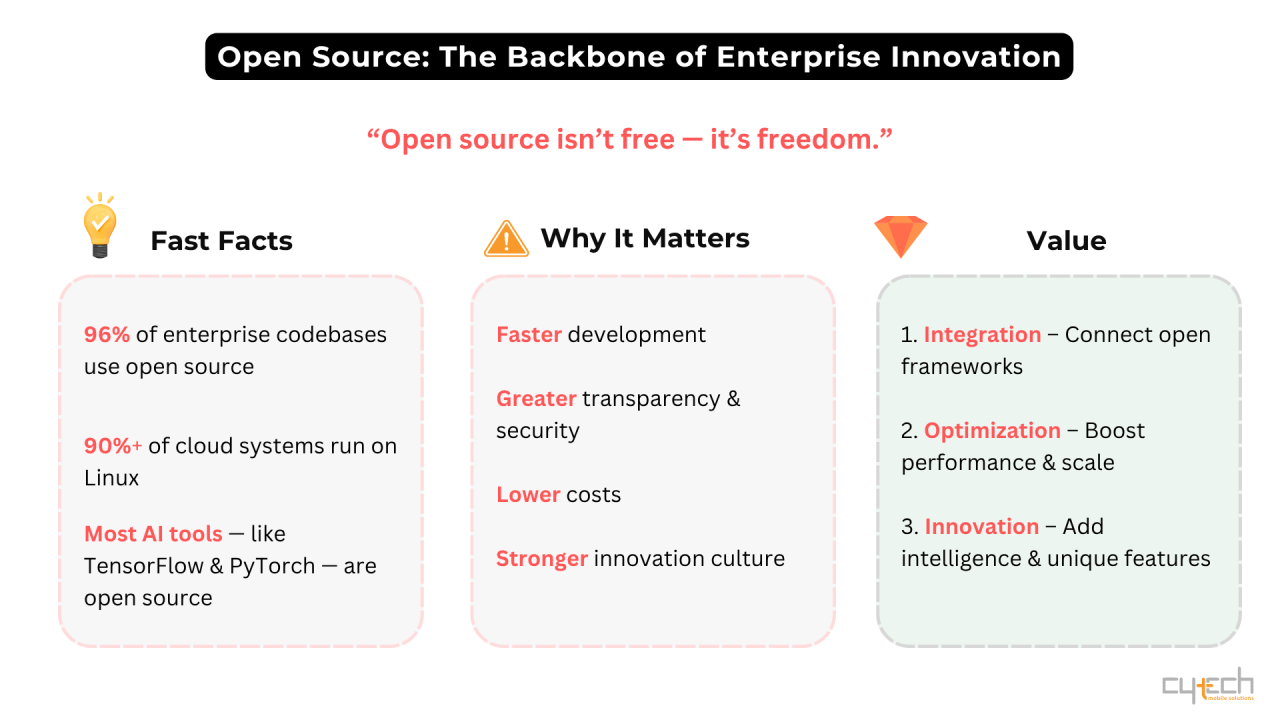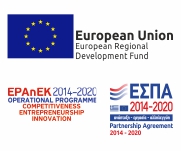Table of Contents
When software and programming began to gain ground, open source was more of a philosophy than a business strategy — a belief shared by a community of developers that knowledge and code should be open to accelerate progress.
Today, that philosophy has become a pillar of enterprise innovation.
Open Source Software (OSS) is no longer an alternative or “experimental” option. It is the foundation on which the world’s most critical digital infrastructures are built.
From Philosophy to Infrastructure
For many years, enterprises viewed open source as a risk — a potential security concern or a sign of amateurism.
That perception has now completely reversed.
According to the Synopsys OSSRA 2024 Report, 96% of commercial codebases contain open-source software. The reason is clear: innovation moves faster within open ecosystems.
Instead of reinventing the wheel, companies now rely on proven frameworks and focus their efforts on creating value — improving agility, differentiation, and user experience.
Just consider that Linux powers over 90% of all cloud infrastructures, and Kubernetes orchestrates millions of containers every second. These are not just “community tools”; they are the backbone of the modern digital world.
Why Enterprises Are Turning to Open Source
Modern enterprises need speed, interoperability, and scalability. Open source delivers all three — and more.
It also reflects a deeper cultural transformation: the shift from closed, hierarchical innovation to collaborative ecosystems.
Table: Business Value Factors of Open Source
| Factor | How Open Source Enables It |
|---|---|
| Agility & Speed | Pre-built, community-tested frameworks dramatically reduce development time. |
| Cost Reduction | Dependency on costly licenses decreases without compromising quality. |
| Security & Transparency | Open code allows anyone to audit and patch vulnerabilities faster. |
| Talent Attraction | Developers prefer environments that leverage and contribute to open-source projects. |
| Innovation Culture | Encourages experimentation and co-creation beyond the boundaries of a single company. |
The most successful enterprises today do not innovate behind walls. They innovate through networks, with shared tools and shared purpose.
From Code to Value: Commercializing Open Source
The true power of open source does not lie in replication or simple reuse — it lies in creating value around it.
The most mature technology companies worldwide see OSS not as a ready-made solution but as a platform for evolution — a starting point upon which new levels of performance, security, and user experience are built.
Commercializing open source typically follows a three-layer architectural approach:
- Integration Layer – Individual open-source components such as databases, APIs, and message queues are integrated into a unified, cohesive ecosystem.
- Optimization Layer – The system is tuned and adapted to the specific needs of end users, emphasizing performance, reliability, and scalability.
- Innovation Layer – Proprietary tools, dashboards, extensions, or AI modules are added to differentiate and enhance the final product.
This model allows companies to leverage the collective knowledge base of the open-source community while evolving it into something more mature, enterprise-grade, and commercially sustainable.
In this way, open source transforms from a technical choice into a strategic driver of innovation and value, combining the spirit of freedom with the stability of enterprise software — the essence of modern technological maturity.

The Next Frontier: AI, Cloud, and Open Source
The new era of innovation — artificial intelligence and cloud computing — is being built on open-source foundations.
Frameworks like TensorFlow, PyTorch, Apache Kafka, and Kubernetes are the engines powering today’s most radical transformations.
For enterprises, this convergence means faster experimentation, greater adaptability, and freedom from vendor lock-in.
Modern development teams increasingly rely on open technologies for automated pipelines, container orchestration, and data analytics, making enterprise platforms more dynamic and future-ready.
Freedom with Responsibility
Of course, open source is not a “magic solution.” It requires discipline, governance, and responsible participation.
Enterprises adopting OSS must ensure version control, timely security updates, and compliance with licensing obligations.
Responsible companies treat open source not as “free software” but as a shared ecosystem of innovation — one that thrives on contribution, transparency, and continuous improvement.
True freedom in open source is meaningful only when paired with quality, reliability, and trust.
The Next Era of Open Innovation
Open source is not just a technological choice. It is a social and innovation contract — an invitation to collaborate, share, and co-create.
In an age where telecoms, developers, and enterprises increasingly build shared value ecosystems, open source acts as the common language that connects them all.
The coexistence of open ecosystems and enterprise excellence demonstrates that the two are not opposites.
They are two sides of the same coin — the fusion of creative freedom with reliability.
Final Thought
As the boundaries between community-driven and enterprise-driven development fade, the organizations that embrace open ecosystems will define the next generation of digital innovation.
For forward-looking technology companies, open source is not just a development model.
It is an expression of commitment — to building software that inspires, evolves, and endures.

